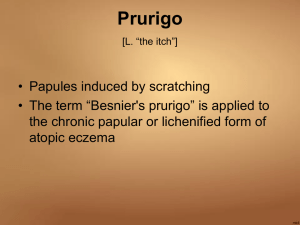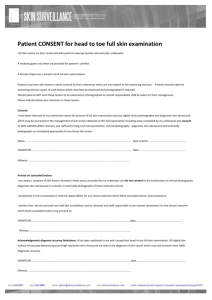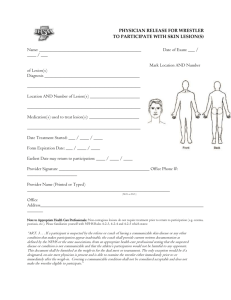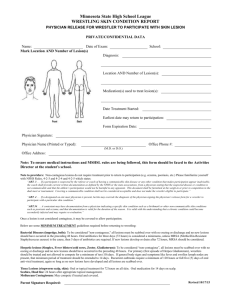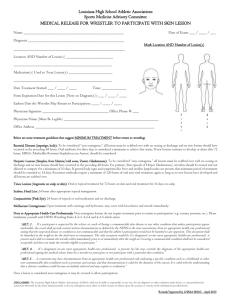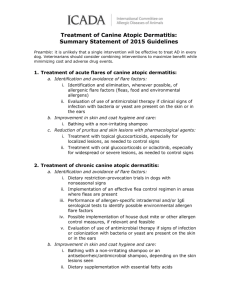Diseases of the skin
advertisement
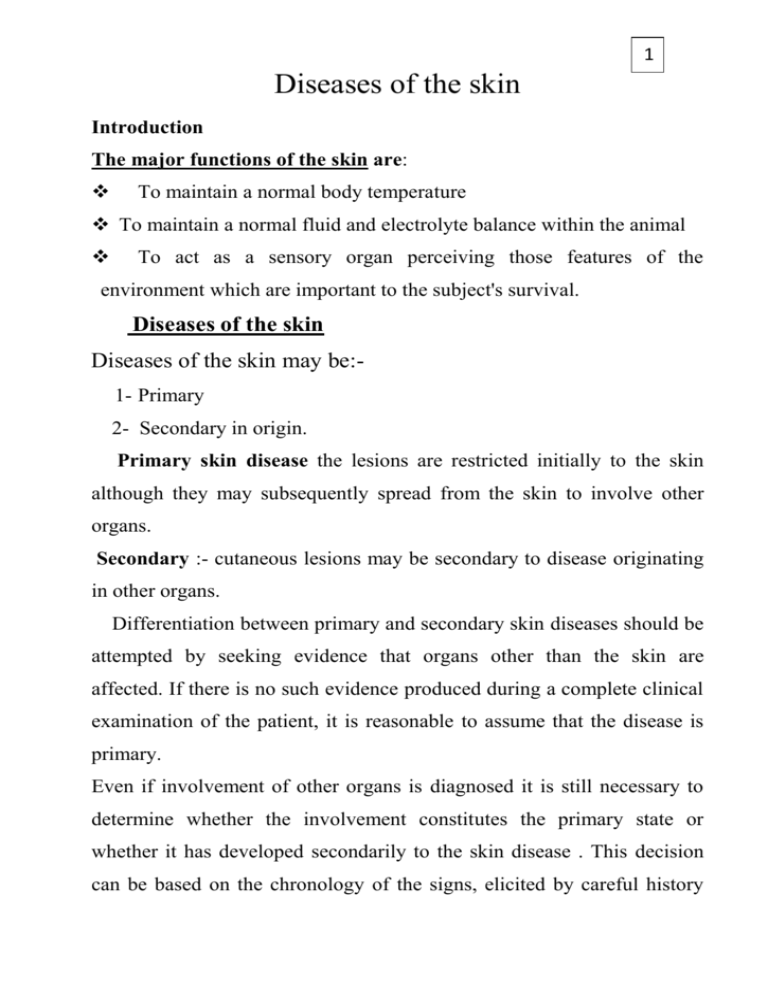
1 Diseases of the skin Introduction The major functions of the skin are: To maintain a normal body temperature To maintain a normal fluid and electrolyte balance within the animal To act as a sensory organ perceiving those features of the environment which are important to the subject's survival. Diseases of the skin Diseases of the skin may be:1- Primary 2- Secondary in origin. Primary skin disease the lesions are restricted initially to the skin although they may subsequently spread from the skin to involve other organs. Secondary :- cutaneous lesions may be secondary to disease originating in other organs. Differentiation between primary and secondary skin diseases should be attempted by seeking evidence that organs other than the skin are affected. If there is no such evidence produced during a complete clinical examination of the patient, it is reasonable to assume that the disease is primary. Even if involvement of other organs is diagnosed it is still necessary to determine whether the involvement constitutes the primary state or whether it has developed secondarily to the skin disease . This decision can be based on the chronology of the signs, elicited by careful history 2 taking, and a detailed knowledge of the individual diseases likely to be encountered. When a careful clinical examination has been made and an accurate history taken it is then necessary to make a careful examination of the skin itself, using the proper technique of examination, especially (and essentially) histopathological examination of a biopsy specimen. It is then possible to determine the basic defect, whether it be inflammatory, degenerative or dysfunctional, and thus to define the type of lesion present. The purpose of this chapter is to describe the basic skin lesions so that the differential diagnosis, up to the point of defining the type and nature of the lesion, the pathoanatomical diagnosis, can be accomplished. Clinical signs and special examination A general clinical examination is followed by a special examination of the skin and must include inspection and, in most cases, palpation. Additional information can be obtained by 1-taking swabs for bacteriological examinations, 2-scrapings for examination for dermatophytes and metazoan parasites, 3-and biopsy for histopathological examination. Biopsy material should include abnormal, marginal, and normal skin. Artifacts are common in biopsy specimens, including non representative sampling, crushing the specimen by forceps or hemostat, and inadequate fixation. Descriptions of lesions should include:- size, depth to which they penetrate, distribution on the body and size of the area covered. 3 Abnormalities of sebaceous and sweat secretion, changes in the hair or wool coat and alterations in color of the skin should be noted, as should the presence or absence of pain or pruritus and the manifestations of skin disease and the common lesions defined below: Lesions An accurate definition of the lesions, is an essential part of a skin patient's clinical record. The table makes a primary differentiation into discrete and diffuse lesions in terms of size, e.g. they may be limited diffuse lesions or extensive localized ones.. Diffuse lesion Discrete lesions Scales Dry, Excoriations Fissures Dry gangrene Early, moist gangrene Keratosis Acanthosis Hyperkeratosis Para keratosis Eczema Hypermelanosis Hypomelanosis Vesicle, bleb, buIla, blister Pustule Wheal Papules (pimples) Nodules, nodes Plaque Acne Comedo Impetigo Scab (or crust) Macule (patch) Abnormal coloration This parameter includes jaundice, pallor and erythema, and these are best seen in the oral or vaginal mucosa or in the conjunctiva. In animals they are rarely visible in light-colored skins. *Red-purple discoloration of the skin of septicemic, 4 *Early erythema is a common finding where more definite skin lesions are to develop, as in early photosensitization. *The blue coloration of early gangrene (e.g. of the udder and teat skin in the early stages of peracute bovine mastitis associated with Staphylococcus aureus) is characterized by coldness and loss of elasticity. Hypopigmentation of the skin:- may be general. As 1- in albino, pseudoalbino and lethal white animals. 2- Local patches of hypopigmentation are characteristic of vitiligo and leukoderma. ----------------------------------------------------------------------- Pruritus Pruritus or itching is the sensation that gives rise to scratching Hyperesthesia is increased sensitivity to normal stimuli " Paresthesia is perverted sensation, a subjective sensation, and not diagnosed in animals. All sensations that give rise to rubbing or scratching are therefore included with pruritus, more properly defined as scratching. Pruritus can arise:from *Peripheral or *Central stimulation. peripheral in origin :It is a primary cutaneous sensation like heat, cold, pain and touch; it differs from pain because it is purely epidermal. whereas pain can still be felt in areas o f skin denuded of epidermis. Thus itching does not occur in the center of deep ulcerations nor in very superficial lesions, such as those of ringworm, where only the hair fibers Skin and keratinized epithelium are involved. 5 Itching can be elicited over the entire skin surface but is most severe at the mucocutaneous junctions. Common causes include the following. cattle Q Sarcoptic and chorioptic mange Aujeszky's disease Nervous acetonemia Lice infestation. Sheep Lice, mange, ked, blowfly and itch mite infestations Scrapie. Horses Chorioptic mange on the legs Queensland (sweet) itch along the dorsum of the body Lice infestation Perianal pruritus due to Oxyuris equi infestation. All species The early stages of photosensitive dermatitis Urticarial wheals in an allergic reaction Licking syndromes' such as occur in cattle on copper-deficient diets are accompanied by pica and the licking of others as well as themselves. They are examples of depraved appetites developed in response to nutritional deficiency and are not a response to pruritus. Itching of central origin derives in the main from the scratch center below the acoustic nucleus in the medulla. It may have a structural basis, as in scrapie and pseudorabies, or it may be functional in origin, as in the nervous form of acetonemia. The only lesions observed are those of a traumatic dermatitis with removal of 6 the superficial layers to a variable depth, breakage or removal of the hairs and a distribution of lesions in places where the animal can bite or rub easily. *********************************** Secretion abnormalities of skin glands The activity of the sweat glands is controlled by the sympathetic nervous system and is for the most part a reflection of body temperature. Excitement and pain may cause sweating due to cerebral cortical activity. A generalized form of hyperhidrosis, apparently inherited, has been recorded in Shorthorn calves. Local areas of increased or decreased sweating may arise from peripheral nerve lesions or obstruction of Principles of treatment of diseases of the skin sweat gland ducts. A generalized anhidrosis is recorded in horses and occasionally in cattle. Excess secretion of sebum by sebaceous glands causes oiliness of the skin or seborrhea but its pathogenesis is poorly understood. Abnormalities of wool and hair fibers alopecia or hypotrichosis :-Deficiency of hair or wool in comparison to the normal pilosity of the skin area . Hirsutism:- abnormal hairiness, manifested by a long, shaggy, usually curly, coat is most common in aged ponies with adenomas of the pars intermedia of the pituitary gland. The character of the fiber may also vary with variations in the internal environment.For example, in copper deficiency the crimp of fine wool fibers is lost and the wool becomes straight and 'steely'. Alternation in coat color, achromotrichia, may be generalized or segmental along the fiber. 7 Principles of treatment of diseases of the skin Primary treatment Primary treatment commences with removal of hair coat and debris to enable topical applications to come into contact with the causative agent. Accurate diagnosis of the cause must precede the selection of any topical or systemic treatment. In bacterial diseases sensitivity tests on cultures of the organism are advisable. Specific skin diseases due to bacteria, fungi and metazoan parasites are reasonably amenable to treatment with the appropriate specific treatment. Bacterial resistance to antimicrobials used in veterinary dermatological practice is a concern. The broad application of antimicrobials for various therapeutic and non therapeutic purposes has accelerated the spread of pre- existing resistance genes and led to the apparent development of mechanisms by which resistance genes are spread, not only within a bacterial species, but also between bacterial species. Every veterinarian must be careful in using of antimicrobials in order to minimize the resistance problem. Removal of the causative agent in allergic diseases and photosensitization , may be impossible and symptomatic treatment may be the only practicable solution. In many cases, too, the primary disease may be confounded by the presence of a secondary agent, which can lead to confusion in diagnosis. Treatment may be unsuccessful if both agents are not treated. 8 SUPPORTIVE TREATMENT Supportive treatment includes prevention of secondary infection by the use of bacteriostatic ointments or dressings and the prevention of further damage from scratching. Effective treatment of pruritus depends upon the reduction of central perception of itch sensations by the use of ataractic, sedative or narcotic drugs administered systemically or on successful restraint of the mediator between the lesion and the sensory end organ. In the absence of accurate knowledge of the pathogenesis of pain it is usual to resort to local anesthetic agents, which are short lived in their activity, and corticosteroids, which are longer acting and effective, provided that vascular engorgement is part of the pruritus-stimulating mechanism, When large areas of skin are involved it is important to prevent the absorption of toxic products by continuous irrigation or the application of absorptive dressings. Losses of fluid and electrolytes should be made good by the parenteral administration of isotonic fluids containing the necessary electrolytes Ensure an adequate dietary intake of protein, particularly sulfurcontaining amino acids to facilitate the repair of skin tissues )

